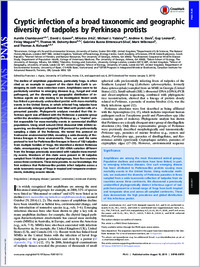Cryptic infection of a broad taxonomic and geographic diversity of tadpoles by Perkinsea protists.
- Chambouvet A Biosciences, College of Life and Environmental Sciences, University of Exeter, Exeter EX4 4QD, United Kingdom; Department of Life Sciences, The Natural History Museum, London SW7 5BD, United Kingdom; t.a.richards@exeter.ac.uk a.chambouvet@gmail.com.
- Gower DJ Department of Life Sciences, The Natural History Museum, London SW7 5BD, United Kingdom;
- Jirků M Institute of Parasitology, Biology Centre, Czech Academy of Sciences, 370 05 Ceske Budejovice, Czech Republic;
- Yabsley MJ Warnell School of Forestry and Natural Resources, The University of Georgia, Athens, GA 30602; Southeastern Cooperative Wildlife Disease Study, Department of Population Health, College of Veterinary Medicine, The University of Georgia, Athens, GA 30602;
- Davis AK Odum School of Ecology, The University of Georgia, Athens, GA 30602;
- Leonard G Biosciences, College of Life and Environmental Sciences, University of Exeter, Exeter EX4 4QD, United Kingdom;
- Maguire F Department of Life Sciences, The Natural History Museum, London SW7 5BD, United Kingdom; Genetics, Ecology and Evolution, University College London, London WC1E 6BT, United Kingdom;
- Doherty-Bone TM Department of Life Sciences, The Natural History Museum, London SW7 5BD, United Kingdom; School of Geography, University of Leeds, Leeds LS2 9JT, United Kingdom; School of Biology, University of Leeds, Leeds LS2 9JT, United Kingdom;
- Bittencourt-Silva GB Department of Environmental Sciences, University of Basel, CH-4056 Basel, Switzerland;
- Wilkinson M Department of Life Sciences, The Natural History Museum, London SW7 5BD, United Kingdom;
- Richards TA Biosciences, College of Life and Environmental Sciences, University of Exeter, Exeter EX4 4QD, United Kingdom; CIFAR Program in Integrated Microbial Biodiversity, Canadian Institute for Advanced Research, Toronto, ON, Canada M5G 1Z8 t.a.richards@exeter.ac.uk a.chambouvet@gmail.com.
- 2015-08-12
Published in:
- Proceedings of the National Academy of Sciences of the United States of America. - 2015
alveolates
emerging disease
frog decline
molecular diversity
parasite
Alveolata
Amphibians
Animals
Geography
Larva
Phylogeny
Species Specificity
English
The decline of amphibian populations, particularly frogs, is often cited as an example in support of the claim that Earth is undergoing its sixth mass extinction event. Amphibians seem to be particularly sensitive to emerging diseases (e.g., fungal and viral pathogens), yet the diversity and geographic distribution of infectious agents are only starting to be investigated. Recent work has linked a previously undescribed protist with mass-mortality events in the United States, in which infected frog tadpoles have an abnormally enlarged yellowish liver filled with protist cells of a presumed parasite. Phylogenetic analyses revealed that this infectious agent was affiliated with the Perkinsea: a parasitic group within the alveolates exemplified by Perkinsus sp., a "marine" protist responsible for mass-mortality events in commercial shellfish populations. Using small subunit (SSU) ribosomal DNA (rDNA) sequencing, we developed a targeted PCR protocol for preferentially sampling a clade of the Perkinsea. We tested this protocol on freshwater environmental DNA, revealing a wide diversity of Perkinsea lineages in these environments. Then, we used the same protocol to test for Perkinsea-like lineages in livers of 182 tadpoles from multiple families of frogs. We identified a distinct Perkinsea clade, encompassing a low level of SSU rDNA variation different from the lineage previously associated with tadpole mass-mortality events. Members of this clade were present in 38 tadpoles sampled from 14 distinct genera/phylogroups, from five countries across three continents. These data provide, to our knowledge, the first evidence that Perkinsea-like protists infect tadpoles across a wide taxonomic range of frogs in tropical and temperate environments, including oceanic islands.
- Language
-
- English
- Open access status
- bronze
- Identifiers
-
- DOI 10.1073/pnas.1500163112
- PMID 26261337
- Persistent URL
- https://sonar.rero.ch/global/documents/102056
Statistics
Document views: 22
File downloads:
- fulltext.pdf: 0
